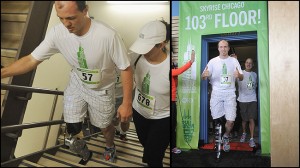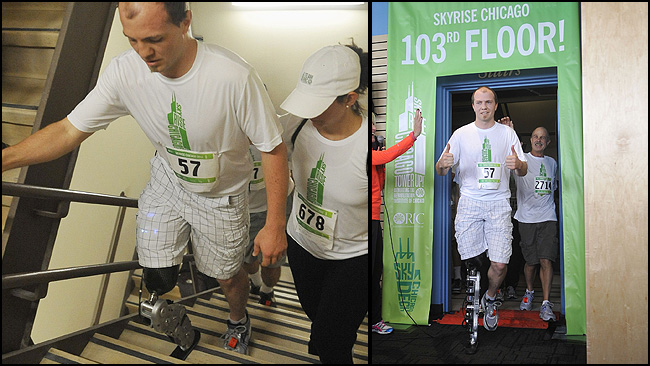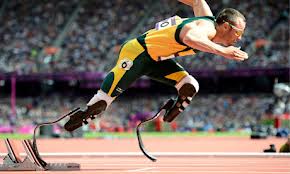It took Zac Vawter 45 minutes to climb the 103 floors of the Willis Tower in Chicago at a charity event this week. He was among 3,000 to join “SkyRise Chicago,” aimed at helping raise money for the Rehabilitation Institute of Chicago. What made Zac’s effort a bit different from others who participated? A number of years ago Zac lost a leg in a motorcycle accident. The prosthetic replacement he wears, however, comes right out of “The Six Million Dollar Man,” except so far it has cost $8 million. The leg is bionic. It weighs a little over 4.5 kilograms (10 pounds) and is designed to respond to Zac’s thoughts. When he wants to climb a set of stairs the leg reads his intent by interpreting the electrical impulses sent to it from Zac’s hamstring muscle. It then responds by synchronizing its two motors, belts and joints to flex appropriately at the knee and ankle. The prototype is not yet ready for commercial production.
After the climb Zac didn’t get to keep his bionic leg. It went back to the engineering and design team at Vanderbilt University, MIT, University of Rhode Island and University of New Brunswick, who continue to make improvements. The commercial version is less than a decade away.

Bionic legs represent one of the many ways science and technology are modifying human bodies in the 21st century. It joins recently announced technologies like Braingate, a surgically implanted device that allows a paralyzed individual to think something to control the use of a prosthetic arm. Or cochlear implants that restore hearing to partially deaf people. Or Nano Retina, a device that restores partial sight to the blind. Or Ekso Bionics‘ exoskeleton that allows paralyzed individuals to walk, or the half-blade legs that Oscar Pistorius, the South African athlete, used to compete in this summer’s Olympics.
So what is on the horizon for we humans in the 21st century? Here are seven enhancements that are coming off the drawing board and soon may be a part of our reality:
- Memory booster pills to increase learning retention and reverse Alzheimer’s.
- Neuro-feedback devices for mind control.
- Protein and enzyme altering drugs to enhance performance in sports and physical demanding work.
- Cures for inheritable diseases through gene therapy.
- Organ regeneration using somatic cells from your own body.
- Regrowing fingers and limbs.
- Prolonging active, healthy lives well beyond the century mark.











